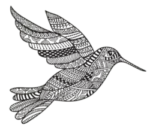(Or: How to Help Nature’s Tiniest Patients with the Greatest Care)
When a hummingbird needs help, the line between rescue and harm can be thinner than a human hair. These remarkable creatures, with their rapid metabolism and delicate physiology, require specialized care that combines urgency with expertise. While the instinct to help is admirable, understanding proper rescue procedures can make the difference between saving a life and unintentionally causing harm.
Let’s begin with some critical facts that every potential rescuer should know:
- Professional rehabilitation is always the best option
- Time is extremely critical – minutes matter
- Legal permits are required for rehabilitation
- Improper care can be fatal
- Contact with humans should be minimized
The First Response
The moment you encounter a hummingbird in distress is crucial. Like any emergency response, the first few minutes can determine the outcome. Your primary role is to provide temporary stabilization while arranging professional care.
Immediate priorities include:
- Ensuring the bird is in immediate safety
- Protecting from predators
- Maintaining appropriate temperature
- Minimizing handling
- Contacting professional help immediately
When to Intervene
Understanding when a hummingbird truly needs help is crucial. Not every bird you find on the ground needs rescue, and some apparent emergencies are actually normal behaviors.
Intervention is needed when:
- The bird has obvious injuries
- It’s been caught by a cat or other predator
- It’s unable to fly after reasonable rest
- Young birds are found far from their nest
- There’s clear signs of illness or weakness
Emergency Care Steps
If professional help isn’t immediately available, proper temporary care becomes critical. Remember, your goal is stabilization, not long-term care.
Essential steps include:
- Creating a safe, quiet, warm environment
- Using proper container preparation
- Maintaining appropriate temperature
- Providing emergency sugar-water solution
- Minimizing stress and handling
Professional Networks
Building connections with wildlife professionals before emergencies occur can save precious time when minutes count.
Important contacts include:
- Licensed wildlife rehabilitators
- Local veterinary services
- Wildlife rescue organizations
- Bird conservation groups
- Emergency wildlife response teams
The Transportation Challenge
Moving an injured hummingbird requires careful planning and execution. These tiny patients are incredibly vulnerable to temperature changes and stress during transport.
Transport considerations include:
- Proper container selection
- Temperature maintenance
- Minimal movement
- Proper ventilation
- Quick, direct routes to care
The Rehabilitation Process
Understanding the rehabilitation process helps set realistic expectations and ensures better outcomes through proper initial care.
Key rehabilitation stages include:
- Initial assessment and stabilization
- Medical treatment if needed
- Controlled environment recovery
- Flight rehabilitation
- Careful release planning
Prevention Strategies
Many hummingbird emergencies can be prevented through proper habitat management and awareness.
Prevention methods include:
- Window collision prevention
- Safe feeder placement
- Regular feeder cleaning
- Predator protection
- Natural habitat preservation
Legal Considerations
Hummingbird rescue and rehabilitation are regulated activities that require proper permits and training.
Legal requirements include:
- Federal and state permits
- Proper documentation
- Training certification
- Release protocols
- Reporting requirements
The Release Process
Successful rehabilitation culminates in release, but timing and conditions must be carefully considered.
Release factors include:
- Weather conditions
- Time of day
- Season considerations
- Location selection
- Follow-up monitoring
Building Better Support Systems
Creating community awareness and support networks can improve outcomes for injured hummingbirds.
Community efforts include:
- Education programs
- Quick response networks
- Resource sharing
- Training opportunities
- Public awareness campaigns
Conclusion: Compassionate Care with Expertise
While the desire to help an injured hummingbird is natural and admirable, the best help often comes from knowing when and how to connect these tiny patients with professional care.
Remember: When you encounter a hummingbird in distress, your most important role is often serving as the vital link between emergency and expert care. Quick, informed action followed by professional intervention gives these remarkable birds their best chance at recovery.
Post Script: Some rehabilitators suspect hummingbirds appreciate proper rescue protocols more than amateur attempts at care. The birds maintain their professional patient status on this matter, but their improved recovery rates with expert care suggest they might prefer treatment from those who know exactly what they’re doing.


